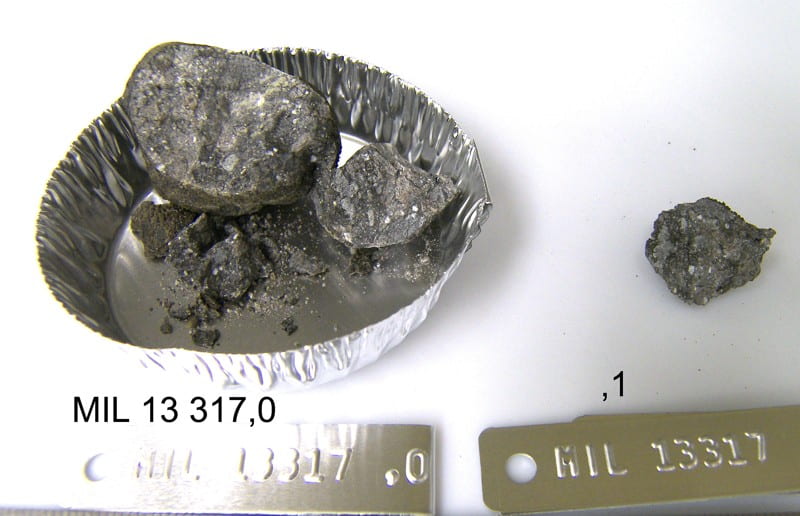Lunar Meteorite: Miller Range 13317


| Listed in The Meteoritical Bulletin, No. 104 Classification from Antarctic Meteorite Newsletter, Vol. 38, No. 2, 2015 Miller Range 13317 (MIL 13317)Miller Range, Transantarctic Mountains, Antarctica Lunar-Anorthositic Breccia Macroscopic Description: Mitchell Haller. A patch of glossy black fusion crust covers 25% of the exterior. Areas without fusion crust have a greenish tint with large inclusions visible. The interior is a light to dark gray breccia with white inclusions and numerous clasts ranging in size from 1 mm to 1 cm. Thin Section (,2) Description: Cari Corrigan, Tim McCoy. This meteorite is a breccia comprised of coarse- and fine-grained clasts up to 8 mm in maximum dimension, set in a comminuted matrix. The clasts are heavily shocked to impact melted. Pyroxenes range from Fs28Wo11 to Fs49Wo35 with a nearly continuous range of intermediate compositions. The Fe/Mn ratio of the pyroxene is ~60. Plagioclase is An80-98Or0-1. The meteorite is lunar. |
| Randy Says… Miller Range 13317 is distinct from the other MIL lunar meteorites. Among lunar meteorites from Antarctica, it is the richest in KREEP (e.g., 9.9 ppm Sm). |
More InformationMeteoritical Bulletin Database MIL 13317 Map References Curran N. C., Joy K. H., Pernet-Fisher J. F., and Burgess R. (2016) A new basaltic-bearing lunar meteorite Miller Range 13317. 47th Lunar and Planetary Science Conference, abstract no. 1516. Curran N. C., Joy K. H., Snape J. F., Pernet-Fisher J. F., Gilmour J. D., Nemchin, A. A., Whitehouse, M. J., and Burgess R. (2019) The early geological history of the Moon inferred from ancient lunar meteorite Miller Range 13317. Meteoritics & Planetary Science, 54, 1401-1430. Korotev R. L. and Irving A. J. (2016) Not quite keeping up with the lunar meteorites – 2016. 47th Lunar and Planetary Science Conference, abstract no. 1358. Pernet-Fisher J. F., Nottingham M., Curran N. M. , and Joy K. H. (2020) Cosmic-ray exposure histories of Th-rich lunar regolith breccias. 51st Lunar and Planetary Science Conference, abstract no. 1376. Robinson K. L., Nagashima K., Huss G. R., Taylor G. J, and Kring D. A. (2019) An ancient KREEP-poor, chlorine-37-rich source within the Moon. 50th Lunar and Planetary Science Conference, abstract no. 2063. Shaulis B. J., Kring D. A., Lapen T. J., and Righter M. (2016) Petrology and distribution of U-Pb ages in lunar meteorite breccia Miller Range (MIL) 13317. 47th Lunar and Planetary Science Conference, abstract no. 2027. Snape J. F., Nemchin A. A., Bellucci1 J. J., and Whitehouse M. J. (2018) Tracing the sources of lunar volcanism with Pb isotopes. Goldschmidt2017, abstract no, 2017002947. Snape J. F., Curran N. M., Whitehouse M. J., Nemchin A. A, Joy K. H., Hopkinson T., Anand M., Bellucci J. J., Kenny G. G. (2018) Ancient volcanism on the Moon: Insights from Pb isotopes in the MIL 13317 and Kalahari 009 lunar meteorites. Earth and Planetary Science Letters 502, 84-95. Zeigler R. A. and Korotev R. L. (2016) Petrography and geochemistry of lunar meteorite Miller Range 13317. 47th Lunar and Planetary Science Conference, abstract no. 2554. Zeigler R. A. and Korotev R. L. (2016) Petrography, geochemistry, and pairing relationships of basaltic lunar meteorite Miller Range 13317. 79th Annual Meeting of the Meteoritical Society, abstract no. 6257. |